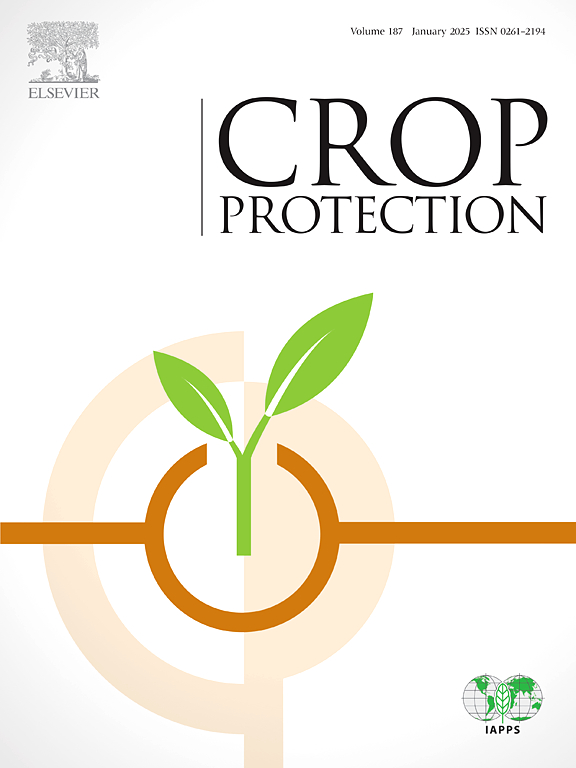新型杀菌剂防治西兰花霜霉病的田间评价——混合效应模型分析
IF 2.5
2区 农林科学
Q1 AGRONOMY
引用次数: 0
摘要
花椰菜是一种营养丰富的蔬菜,但它的生产受到由透明肉芽孢虫寄生引起的霜霉病的阻碍。本研究旨在评价2021-22和2022-23生长季节不同杀菌剂对西兰花霜霉病的田间防治效果。九种处理,包括杀菌剂组合和单独产品,在随机完全区组设计中进行试验。施用后每隔15 d评估病害指数和产量。结果表明,氟匹酚内酯+ fosetyal可显著降低病害,综合病害指数(DI)为12.77,产量为244.00 g/头,而未处理的DI为34.43,产量为122.00 g/头。同样,Famoxadone + Cymoxanil和Fenamidone + Mancozeb也非常有效,其DIs分别为16.82和17.93,并提高了产量。回归分析表明,病害与产量呈显著负相关(R2 = 0.887),病害每增加1%,产量降低5.56 g/穗。混合效应模型分析显示,在考虑年份变化的同时,治疗效果显著。本研究得出结论,将不同作用方式的杀菌剂(如Fluopicolide + Fosetyl Al)结合使用,可以有效地治理霜霉病,同时优化产量。本研究强调有必要战略性地施用杀菌剂,以防止耐药性的发展和提高西兰花的可持续生产。本文章由计算机程序翻译,如有差异,请以英文原文为准。
Field evaluation of new fungicides in controlling downy mildew of broccoli - A mixed-effects model analysis
Broccoli (Brassica oleracea var. italica) is a nutritionally rich vegetable, but its production is hampered by downy mildew, caused by Hyaloperonospora parasitica. This study aimed to evaluate the efficacy of various fungicides in managing downy mildew in broccoli under field conditions during the 2021-22 and 2022-23 growing seasons. Nine treatments, including fungicidal combinations and solo products, were tested in a randomized complete block design. Disease index and yield were assessed at 15 day intervals post-application. The results showed that Fluopicolide + Fosetyl Al significantly reduced disease, with a pooled disease index (DI) of 12.77 and increased yield to 244.00 g/head, compared to untreated control with 34.43 DI and 122.00 g/head. Similarly, Famoxadone + Cymoxanil and Fenamidone + Mancozeb were highly effective, with DIs of 16.82 and 17.93 respectively, and increased yields. A regression analysis indicated a strong negative correlation between disease and yield (R2 = 0.887), with each 1% increase in disease resulting in a 5.56 g/head yield reduction. The mixed-effects model analysis revealed significant treatment effects while accounting for year variability. The study concludes that integrating fungicides with different modes of action, such as Fluopicolide + Fosetyl Al, can effectively manage downy mildew while optimizing yield. This research emphasizes the need for strategic fungicide application to prevent resistance development and enhance sustainable broccoli production.
求助全文
通过发布文献求助,成功后即可免费获取论文全文。
去求助
来源期刊

Crop Protection
农林科学-农艺学
CiteScore
6.10
自引率
3.60%
发文量
200
审稿时长
29 days
期刊介绍:
The Editors of Crop Protection especially welcome papers describing an interdisciplinary approach showing how different control strategies can be integrated into practical pest management programs, covering high and low input agricultural systems worldwide. Crop Protection particularly emphasizes the practical aspects of control in the field and for protected crops, and includes work which may lead in the near future to more effective control. The journal does not duplicate the many existing excellent biological science journals, which deal mainly with the more fundamental aspects of plant pathology, applied zoology and weed science. Crop Protection covers all practical aspects of pest, disease and weed control, including the following topics:
-Abiotic damage-
Agronomic control methods-
Assessment of pest and disease damage-
Molecular methods for the detection and assessment of pests and diseases-
Biological control-
Biorational pesticides-
Control of animal pests of world crops-
Control of diseases of crop plants caused by microorganisms-
Control of weeds and integrated management-
Economic considerations-
Effects of plant growth regulators-
Environmental benefits of reduced pesticide use-
Environmental effects of pesticides-
Epidemiology of pests and diseases in relation to control-
GM Crops, and genetic engineering applications-
Importance and control of postharvest crop losses-
Integrated control-
Interrelationships and compatibility among different control strategies-
Invasive species as they relate to implications for crop protection-
Pesticide application methods-
Pest management-
Phytobiomes for pest and disease control-
Resistance management-
Sampling and monitoring schemes for diseases, nematodes, pests and weeds.
 求助内容:
求助内容: 应助结果提醒方式:
应助结果提醒方式:


